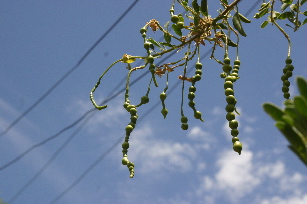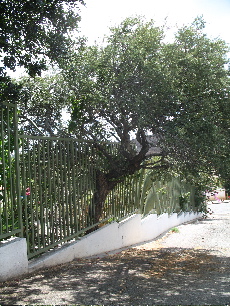2005
Be
well, do good work, and keep in touch |
Compost
January 2005
Namibia, given
the right conditions, is a great place for compost heaps. Problem is,
conditions are seldom right. The rain
here is supposed to start on the Kaiser’s birthday, somewhere near
the end of February, and last for about 3 months. Which is not optimal
for compost development. And the rain is fierce, a centimetre or two
in a quick 20 minute downpour; you don’t, for example, carry an
umbrella, you wait. It runs off compost heaps, leaving all but the to
inch or two crispy dry and unrotted.
But this year the rain has been relatively gentle and frontal; cold rain
circulating from the South Atlantic rather than hot rain sucked down from
the topics by the low pressure over South Africa. This year the rain has
soaked in.
In this climate, the normal two-year rotting cycle happens in a few weeks.
And today I have been turning over my heap to reveal all the joys within.
This is actually quite a tricky job because it fills up with snakes laying
their eggs among the normally dry and warm piles of leaves. But today it
was a seething mass of decomposers of all different shapes and sizes and
phylae, plying their different trades in the steamy warm protected environment.
Up above in the tree a pied barbet screamed at me. You would have thought
that it would have welcomed my overturning of the heap to reveal all that
it could ever want to eat in a lifetime, but birds here are not like birds
in Britain, they don’t come and perch elegantly on the fork handle
to hop down whenever I unearthed a juicy cutworm, they are naturally garish
in appearance and naturally irritable in disposition. (And the most irritable
of them all is a thing called a dusky sunbird that eats insects washed
down with nectar. It is tiny and knows it. It makes up for it by tut-tutting
at us all loudly and disapprovingly whenever it is not destroying my Hibiscus
by sucking the nectar out the quick way by puncturing the back of the flower.
It even screams at us to open the windows so it can come in and disapprove
of us from a perch in the house ficus. Today it sat on the Landrover all
day disapproving of another sunbird invading its territory in the wing
mirror.)
I shovelled all the most friable compost onto the nearby vegetable plot
and ricked my back. I have also lost a bet of a litre of 10 year Highland
Park (95 points out of 100 in the guide) because I predicted a dry year.
Time to go and lie down in the desert for a day or two to recover.
Biokineticism
March 2005
Today,
I acquired a biokineticist. Well, she is not exactly my personal biokineticist
as I share her with many others. She is about sixteen years old (though
you can never tell with Afrikaners) and blonde (though you can never
tell with Afrikaners) and I pay her money to give me silly things to
do. One of which is standing on one foot on the bed. It is good for
the foot, she says, but she did not say which one. Picking up peanuts
with my toes was another. Though not simultaneously, I was advised.
The first silly thing she gave me to do, however, was to spend five
minutes riding nowhere on a bicycle. This bicycle has a little screen
in front of me which told
me my energy output in calories and my power output in watts (obviously American-made).
Having nothing to do except study these things I noted that my power output was
about 80 watts which, it struck me, could not be much more than the power output
of my daughter’s hamster as it ran around the living room inside its transparent
hamster ball (before it died). My biokineticist was clearly taking no risks.
I glanced at the man next to me who was walking very fast getting nowhere. I
recognised him as the former Prime Minister. It occurred to me that walking fast
and getting nowhere was a particularly conspicuous feature of Namibian politics
so I should not be surprised. I share my biokineticist with a former Prime Minister.
I was then introduced to the esoteric experience of standing on a stationery
football and making it move around. After that the excitement mounted as I was
shown all sorts of interesting things that you could do with a bit of old innertube.
And finally the ultimate; leaning against a wall. I have to lean against a wall
for two lots of 30 seconds per day, three days a week. It is, so they say, very
good for walls.
Watch this space for progress reports.
My biokineticist has deep brown eyes.
Notes from the Somerset silly season
July 2005
I’m
back in Somerset and its clearly July; you can tell from the news items.
In a redevelopment
of a tatty bit of Newquay in Cornwall,
owned by the Duchy of Cornwwall, The Prince Charles wants to build a
mosque there. The local people say there are no Moslems in Newquay and
they would rather have a bowling alley.
And of course, down this way its Glastonbury Festival which accounts
for the bad weather we flew into. Each year 100 000 people from towns
think
its neat to wade up to their knees in Somerset mud (generally regarded
as among the World’s best, it has a thick yellowish colour and sticks
to all the parts not often reached by ordinary mud). Yesterday the mud
parted and up to the podium strode Saint Bob; ‘Say after me, MAKE
POVERTY HISTORY’. Many of them got it right first time.
Maybe the prince should think of a dual purpose building for Newquay
- a kind of Bowling Allah
Gillian Grieg (pron. Greg)
July 2005Gillian
Grieg runs the best sheet and recorded
music shop in the west of England.
Its
in a Taunton back street because none of her
customers are ‘drop-in’.
My CD collection is now very considerable because
it is based not on what I like but on what is in Gillian’s reject boxes. I called in the
other day and was welcomed like the prodigal son ‘Mr Namibia’ she
said ‘I haven’t seen you for a long time’ (Gillian, characteristically
has long solved the forgetting name problem by inventing her own). I look
apologetic. I explain that the Americans, as part of their efforts to bring
sweetness and light to us all, instituted a digital radio channel via the
Worldspace satellite called Maestro (“the channel where Beethoven
lives”). For a while I tended to use it instead of listening to my
CDs as it was cheaper. There were, however two problems. The first was
that they only had one CD, Mussorgski’s ‘Night on a Bare Mountain’ which
saturates before you have heard in the first time never mind ad nauseam.
The second problem was that after a year or so they decided that Maestro
should be encoded and that we should have to pay for decoding. So I returned
to Gillian’s reject box.
Now, the really alarming thing about Gillian’s reject box these
days is that it contains CDs by all the people who, in my age, were
the greatest;
Emma Kirkby and Anthony Rooley/Andrew Parrott. Even Evelyn Tubb was
in there. Evelyn. My thoughts drifted back to that pub, ‘The
Bridge’,
at Grinton-on-Swale in the Yorkshire Dales, so many years ago.
I cant remember the precise date. It was about a quarter of a century
ago. I was in the One-stop-shop at Reeth buying a few provisions. I
was with
wife Jane and the children and the Stackhouses (Glynne Stackhouse was
British Council director in Botswana and associate conductor of the
Gaborone
Orchestra
and Chorus.
No less). We came out of the shop (now shoppe) to notice that a group
called the Consort of Musicke was singing the Cries of London on Reeth
Green.
It was a trailer, we later discovered, for the Ockeghem Requiem (the
earliest surviving setting of the Requiem so we were told) that was
to be performed
that night in Grinton Church, just a mile or so down river and for
which tickets were not going too well among the Dales shepherding community.
As it happened, one of the lead singers at the Grinton gig was one
Emma Kirkby, a Somerset lass that was at university with me but whom
I had
never met. But she was an old friend of Glynne’s. She introduced
me to Anthony Rooley who was in charge. Anthony latched on to my name
Clegg. ‘Are
you related to the former director of education for the West Riding?’ He
went on to explain that he was a washboard player in a skiffle group
in Harrogate (or somewhere) and my father personally interviewed him,
not because of his academic success but because of his musical ability,
and he was given a County Major Award to study music. He subsequently
founded
the Consort
of
Musicke,
dedicated
to unearthing, editing and recording all the lost glorious music of
the golden age of English music of the sixteenth century.
But Evelyn? She was the young ravishing, black-haired, black-eyed second
soprano soloist in the Requiem, singing some duets with Emma. She had
a wonderful voice; a young Emma. We chatted in the bar of the Bridge
after
the Requiem; that is to say, I gazed into her eyes. 25 years ago. Yesterday
there she was, staring up at me from Gillian’s sale box. Same
eyes though.
Towton battlefield, 10GW
July 2005I grew up on the edge of Towton Battlefield. I was back there in June. From the ridge that was defended by the Lancastrians there is a cmmanding view of the Aire valley and crossing many miles to the south. A perfect place for an ambush (except when it's snowing in your face).
This morning was
a beautiful day, cloudless except for a bit of cirrus and four puffy
cumulus clouds, each above its very own
powerstation. The interesting thing was that the cloud came not from
the cooling
towers but from the chimneys, most being a single chimney with four
flues inside, one
from each of the steam generators in the hall. The biggest cloud was
over Drax, a powerstation with four turbines, each capable of generating
1GW.
This means that the output of one turbine at Drax is four times the
total electricity demand for the whole of Namibia.
But the interesting thing is not the cloud that you can see but one
that you cant, which from these coal fired stations is infinitely
bigger, the carbon
dioxide cloud. Within sight of Towton battlefield, four powerstations, built on top of a now mined-out coalfield, contribute probably 1000 times more to global warming than all the
industry
in Namibia.
The interesting thing about Drax, however, is that (as well as it being, apparently, the World's biggest power station) is that it burns anything, including stubble, and more recently a form of quick growing 2m high grass that we are seeing more and more of in the fields around. So far though, the carbon dioxide is not sequestered as far as I know.
Socks
Whitearse
November 2005
A decoction from its roots roots are good for hemorrhoids, a poultice of its leaves will cure cattle of blindness, its flowerbuds, when pickled in vinegar can be used as capers, cattle feed on it during droughts and a fine one where I walk regularly smells strongly of the Wildebeest that use it as a rubbing post. And the Afrikaners make coffee from ts roots, but then the Afrikaners make coffee out of pretty well anything. Its the Witgat tree ('white bottom'*) and you must not cut it down or your calves will be only bull calves. *'gat' in Afrikaans means 'anus' but any literal translation from Afrikaans is a dangerous business because it's a language where almost every word has almost any meaning. It all depends on context.
|
You have to build the fence around it or all your calves will be bull-calves |
No whistles
30th Oct 2005

Our knoppiesboontjieboom in summer. Its English name has given rise to a more than usually depressing shopping mall just over the hill called Maerua Lifestyle Center.
I suppose Knoppiesboontjieboom Lifestyle Centre would not sell quite so much designer underwear
A few feet from each other we have two other indigenous trees, the Knoppiesboontjieboom and the Klokkiesboontjieboom, which are two entirely different species. One, linguists will recognise, has knobs on and the other, bells.
The Knoppiesboontjieboom is also known as the Maerua which gives its name to the area in which we live. It is now covered with delicate flowers with extraordinary long stamens and is the larder of two pairs of dusky sunbirds who cannot tolerate each other. Later it will be the larder of millions of caterpillars of a small white butterfly which will, in just a few days, turn every one of its leaves into slimy green shit and then die of hunger and fall off. Only then can our Maerua relax and start living.
(We're in the market for a Fluitjiesboontjieboom.)

 |
The seed of the Maerua showing the boontjies with nice little knoppies developing |
